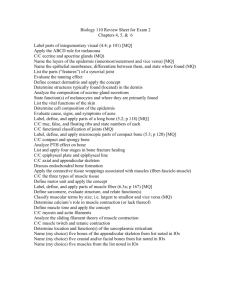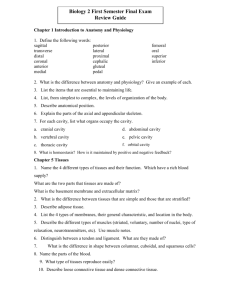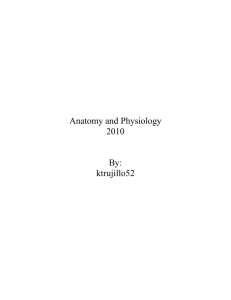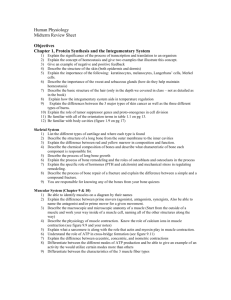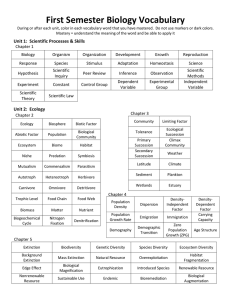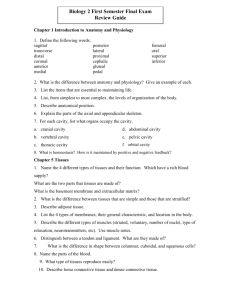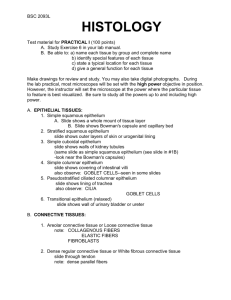Midterm study guide
advertisement
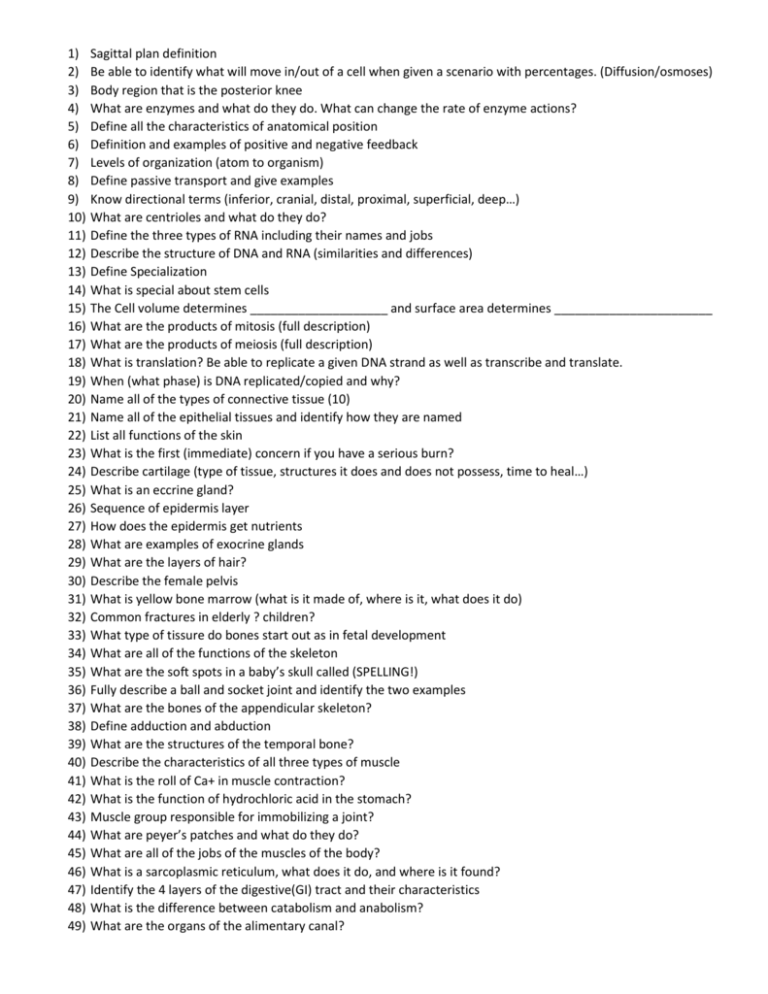
1) 2) 3) 4) 5) 6) 7) 8) 9) 10) 11) 12) 13) 14) 15) 16) 17) 18) 19) 20) 21) 22) 23) 24) 25) 26) 27) 28) 29) 30) 31) 32) 33) 34) 35) 36) 37) 38) 39) 40) 41) 42) 43) 44) 45) 46) 47) 48) 49) Sagittal plan definition Be able to identify what will move in/out of a cell when given a scenario with percentages. (Diffusion/osmoses) Body region that is the posterior knee What are enzymes and what do they do. What can change the rate of enzyme actions? Define all the characteristics of anatomical position Definition and examples of positive and negative feedback Levels of organization (atom to organism) Define passive transport and give examples Know directional terms (inferior, cranial, distal, proximal, superficial, deep…) What are centrioles and what do they do? Define the three types of RNA including their names and jobs Describe the structure of DNA and RNA (similarities and differences) Define Specialization What is special about stem cells The Cell volume determines ____________________ and surface area determines _______________________ What are the products of mitosis (full description) What are the products of meiosis (full description) What is translation? Be able to replicate a given DNA strand as well as transcribe and translate. When (what phase) is DNA replicated/copied and why? Name all of the types of connective tissue (10) Name all of the epithelial tissues and identify how they are named List all functions of the skin What is the first (immediate) concern if you have a serious burn? Describe cartilage (type of tissue, structures it does and does not possess, time to heal…) What is an eccrine gland? Sequence of epidermis layer How does the epidermis get nutrients What are examples of exocrine glands What are the layers of hair? Describe the female pelvis What is yellow bone marrow (what is it made of, where is it, what does it do) Common fractures in elderly ? children? What type of tissure do bones start out as in fetal development What are all of the functions of the skeleton What are the soft spots in a baby’s skull called (SPELLING!) Fully describe a ball and socket joint and identify the two examples What are the bones of the appendicular skeleton? Define adduction and abduction What are the structures of the temporal bone? Describe the characteristics of all three types of muscle What is the roll of Ca+ in muscle contraction? What is the function of hydrochloric acid in the stomach? Muscle group responsible for immobilizing a joint? What are peyer’s patches and what do they do? What are all of the jobs of the muscles of the body? What is a sarcoplasmic reticulum, what does it do, and where is it found? Identify the 4 layers of the digestive(GI) tract and their characteristics What is the difference between catabolism and anabolism? What are the organs of the alimentary canal? 50) What are the accessory organs associated with the digestive system? Diagrams: T1 Cranial cavity Thoracic cavity Dorsal body cavity Golgi apparatus Nucleus Mitochondria Centrioles Anitcubital Sural Buccal Lumbar Scapular Brachial Integumentary system Excretory system Muscle system Reproductive system T2 Anticodon Codon tRNA RNA mRNA ribosome transcription translation DNA amino acid Crossing over occurs Meiosis Makes haploid cells Anaphase II Prophase Mitosis Metaphase T3 Adipose Areolar Hyaline Simple squamous Pseudostratified Exocrine Endocrine Bone Skeletal muscle Hair follicle Muscle in skin Stratum granulosm Stratum cornium Stratum basal Sebaceous gland Sweat gland T4 Canaliculus Ulna Patella Humorous Femur Occipital Zygomatic bone Temporal Parietal Nasal Mandible Diaphysis Articular cartilage Medullary cavity Location of red bone marrow Periosteum Atlas Axis Cervical Lumbar Hyoid bone T5 Ileum Fascicle Epimysium Myosin Masseter Sartorius Incisors Quadriceps group Molar Parietal cell Pyloris Rugau Parotoid gland Tendon Actin




